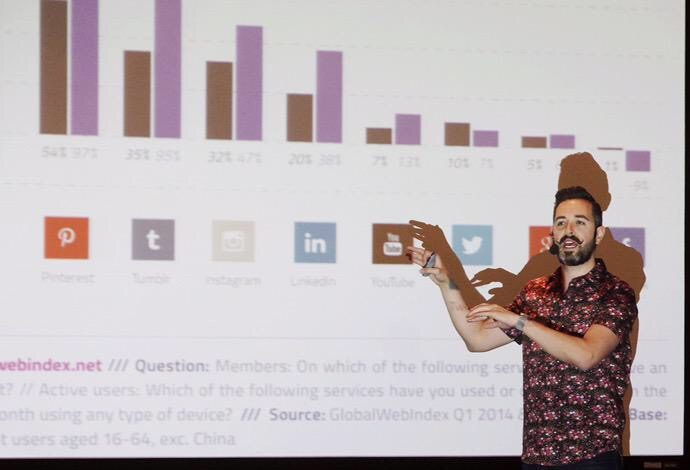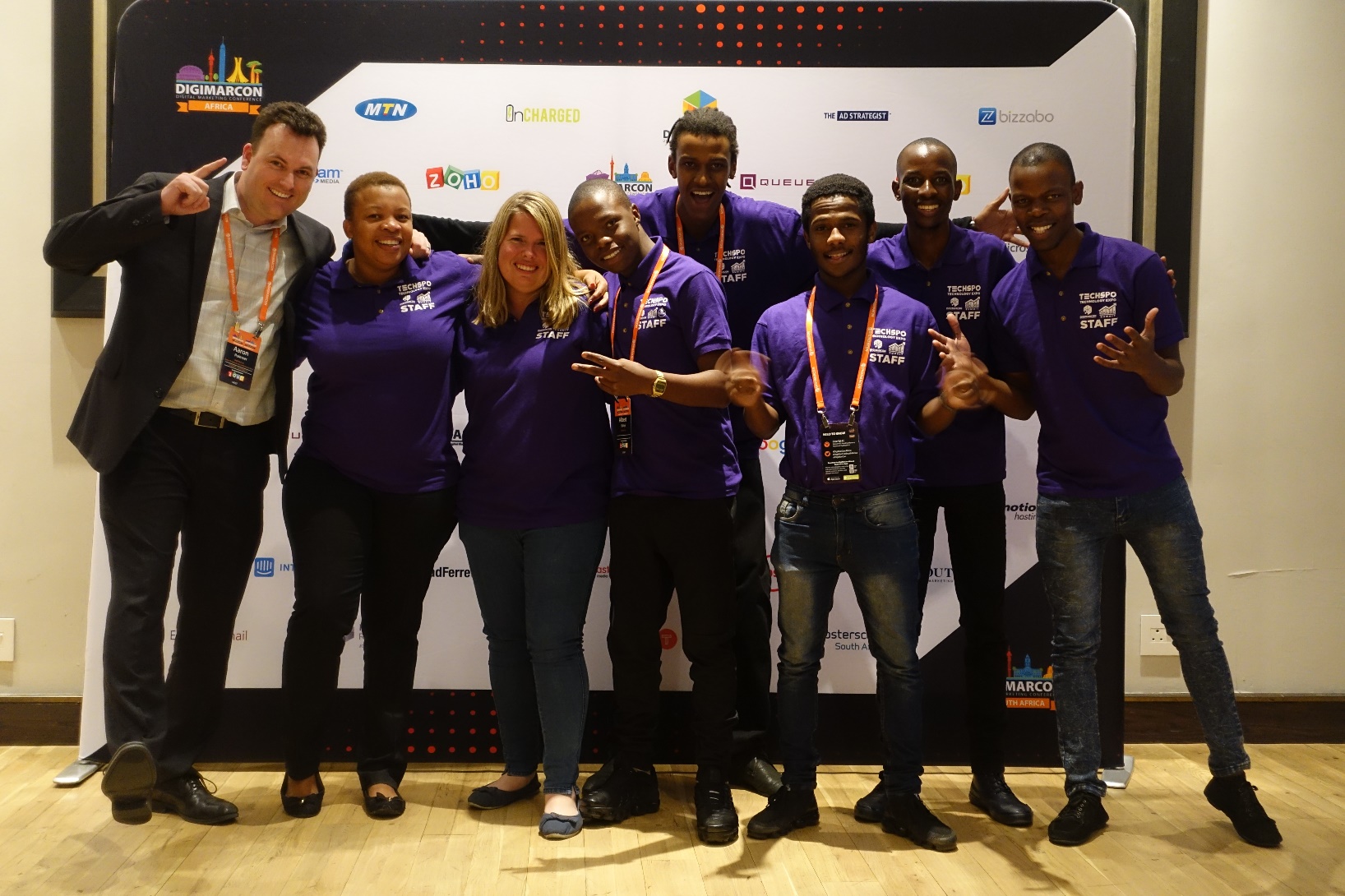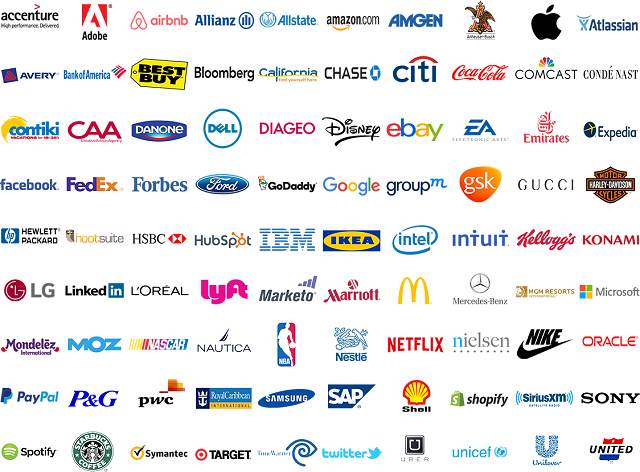Posts Tagged "Content Strategy"
Articles
- Best Marketing Conference Sponsorship
- What Does it Mean to Be an Exhibitor at a Conference?
- What Is the Biggest Social Media Conference?
- What Is an Innovation Conference?
- What Is a Typical B2B Event?
- What Are the Cloud Technology Events in 2025?
- Marketing Event Volunteer Opportunities: A Comprehensive Guide
- Digital Marketing Event Volunteer Opportunities Near Me
- What Does a Volunteer Do at a Conference?
- Is DigiMarCon Worth It?
- Is DigiMarCon Good?
- What is the Biggest Marketing Forum?
- What are Digital Marketing Conferences?
- Marketing Conference Exhibiting: Your Guide to Success
- Digital Summit Comparison: A Closer Look at DigiMarCon
- Digital Marketing Conference
- Digital Marketing Events: Your Guide to Success in 2025
- Marketing Conferences: Unlocking Your Business Potential in 2025
- What Is The Future of Digital Marketing in 2030?
- B2B Event Marketing Strategy: Unlocking Success For Your Business
- Why B2B Event Marketing?
- What Should a B2B Marketing Strategy Include?
- Top Marketing Conferences for 2025
- What Is the Future of Marketing in 2025?
Digital Marketing Conferences
- NORTH AMERICA
- DigiMarCon Cruise
(New Orleans, LA, USA) - DigiMarCon West
(Los Angeles, CA, USA) - DigiMarCon Northwest
(Seattle, WA, USA) - DigiMarCon Canada West
(Vancouver, BC, USA) - DigiMarCon Canada
(Toronto, ON, Canada) - DigiMarCon Canada East
(Montreal, QC, Canada) - DigiMarCon Florida
(Orlando, FL, USA) - DigiMarCon Gulf Coast
(Houston, TX, USA) - DigiMarCon Southern California
(San Diego, CA, USA) - DigiMarCon Midwest
(Chicago, IL, USA) - DigiMarCon Mid-South
(Nashville, TN, USA) - DigiMarCon Great Lakes
(Detroit, MI, USA) - DigiMarCon North
(Minneapolis, MN, USA) - DigiMarCon Central
(Kansas City, MO, USA) - DigiMarCon Texas
(Dallas, TX, USA) - DigiMarCon New England
(Boston, MA, USA) - DigiMarCon Mid-Atlantic
(Philadelphia, PA, USA) - DigiMarCon South Florida
(Miami, FL, USA) - DigiMarCon Southeast
(Atlanta, GA, USA) - DigiMarCon Central Florida
(Tampa, FL, USA) - DigiMarCon East
(New York, NY, USA) - DigiMarCon South Atlantic
(Charlotte, NC, USA) - DigiMarCon America
(Washington, D.C. USA) - DigiMarCon Northern California
(San Francisco, CA, USA) - DigiMarCon Rocky Mountains
(Denver, CO, USA) - DigiMarCon South
(San Antonio, TX, USA) - DigiMarCon Silicon Valley
(San Jose, CA, USA) - DigiMarCon Orange County
(Anaheim, CA, USA) - DigiMarCon Southwest
(Phoenix, AZ, USA) - DigiMarCon World
(Las Vegas, NV, USA)
- DigiMarCon Cruise
- LATIN AMERICA
- EUROPE
- MIDDLE EAST
- AFRICA
- ASIA PACIFIC
- DigiMarCon Hawaii & Pacific
(Honolulu, HI, USA) - DigiMarCon Asia & Japan
(Tokyo, Japan) - DigiMarCon New Zealand
(Auckland, New Zealand) - DigiMarCon Australia
(Sydney, Australia) - DigiMarCon Oceania
(Melbourne, Australia) - DigiMarCon Southeast Asia
(Singapore) - DigiMarCon India
(New Delhi, India) - DigiMarCon North Asia & China
(Shanghai, China)
- DigiMarCon Hawaii & Pacific
- VIRTUAL
Digital Marketing Blog
- What Makes DigiMarCon Stand Out (And Is It Worth It?) October 30, 2025
- Is DigiMarCon Worth Attending? A Complete Breakdown October 29, 2025
- DigiMarCon for Startups: Why Founders Shouldn’t Miss It October 29, 2025
- DigiMarCon Recap: What Went Down and What’s Next October 29, 2025

































Inspire, Educate, Empower: Speak at DigiMarCon
DigiMarCon stands as the preeminent digital marketing, media, and advertising conference & exhibition series, spanning all continents annually. By assuming the role of a keynote speaker at this esteemed industry conference, professionals have the opportunity to disseminate their knowledge to a vast audience.
Engagement in DigiMarCon presents a singular opportunity to inspire, educate, and empower a global assembly of digital marketing professionals. It serves as a conduit for industry luminaries to solidify their positions as thought leaders, enhance brand visibility, and contribute to the digital marketing domain’s evolution.
Participation in such a monumental digital marketing event facilitates networking with peers, the exchange of knowledge, and the acquisition of insights into the latest industry developments. This engagement can be a transformative moment in one’s career trajectory, affording international acclaim.
The Power of Sharing Your Digital Marketing Expertise
Engaging in public speaking, a platform like DigiMarCon offers, can profoundly elevate your professional standing. By stepping onto the podium, you not only disseminate your insights but also unlock avenues for professional growth. This exposure can catalyze career progression, forge novel business alliances, and amplify your company’s visibility.
Why Industry Leaders Choose to Speak at Conferences
Industry luminaries opt for conference platforms to disseminate their wisdom, fortify their personal brand, and forge connections with peers. These engagements serve as a showcase for their acumen, cementing their status as digital marketing thought leaders. Such endeavors foster enhanced credibility and trust among prospective clients and collaborators.
Conferences also present a singular chance to remain abreast of the latest industry developments and innovations. Through dialogue with fellow experts and the exchange of experiences, leaders can acquire invaluable knowledge. This knowledge is instrumental in shaping their business strategies.
How Speaking Builds Your Personal and Company Brand
Participating in events such as DigiMarCon can significantly augment your personal brand. By articulating your expertise, you underscore your proficiency and versatility, rendering you more appealing to prospective clients and partners. This heightened visibility can precipitate new business ventures and collaborations, ultimately benefiting your enterprise.
Conversely, your company’s brand also experiences a notable uplift when you take the stage. Your presence imbues your organization with credibility, and the association with a seasoned professional enhances your company’s industry standing.
What Makes DigiMarCon a Premier Speaking Platform
DigiMarCon, with its expansive global footprint and heterogeneous audience, has solidified its status as a preeminent platform for industry luminaries to disseminate their expertise. This esteemed reputation is predicated upon several critical elements, rendering it an exemplary industry conference for digital marketing aficionados.
DigiMarCon’s Global Reach and Event Locations
DigiMarCon orchestrates gatherings in 13 nations, spanning 33 metropolises globally, creating a vast arena for orators to engage a worldwide constituency. This extensive outreach ensures that speaking opportunities at digital marketing conferences transcend geographical constraints.
Audience Demographics and Engagement Levels
The DigiMarCon audience is a tapestry of industry stalwarts, innovators, and entrepreneurs. This eclectic mix fosters a vibrant exchange of ideas and elevates engagement among attendees.
Success Stories from Past DigiMarCon Speakers
Many keynote speakers at DigiMarCon have documented substantial impacts on their professional stature and business prospects. These narratives highlight the intrinsic value of presenting at DigiMarCon.
Benefits of Becoming a DigiMarCon Speaker
Engagement as a speaker at DigiMarCon presents a singular opportunity to solidify your status as a vanguard in the digital marketing domain. This platform allows for the dissemination of your specialized knowledge to a precisely targeted audience, significantly augmenting your professional credibility and visibility within the industry.
Establishing Yourself as an Industry Authority
Presenting at DigiMarCon serves as a testament to your proficiency and showcases your acumen in digital marketing. This speaking engagement fosters trust among prospective clients and partners, cementing your status as an expert speaker within your niche. Such recognition can catalyze the emergence of new business prospects.
Networking Opportunities with Digital Marketing Leaders
DigiMarCon’s diverse assembly of digital marketing professionals offers a prime environment for networking. As a speaker, you will engage with other industry luminaries, prospective clients, and partners, forging connections that can catalyze collaborations and business expansion. The conference’s setting encourages profound discussions and exchanges, instrumental for career progression.
Business Growth and Partnership Possibilities
Engagement as a DigiMarCon speaker can significantly enhance your brand’s visibility, unlocking new avenues for business expansion. The prestige of being an expert speaker can attract new clientele and partners, potentially generating new speaking opportunities and collaborations. The credibility derived from speaking at a distinguished conference like DigiMarCon can be a decisive factor in securing booking speaker engagements for other events.
In conclusion, participation in DigiMarCon offers a multifaceted platform for professional development, networking, and business expansion. By capitalizing on this opportunity, you can elevate your industry standing, forge valuable connections, and explore novel business avenues.
Types of Speaking Opportunities at DigiMarCon
DigiMarCon presents a plethora of speaking opportunities for professionals within the digital marketing sphere. It caters to both seasoned experts and burgeoning voices, ensuring a myriad of avenues for sharing insights and engaging with a global audience.
The conference’s diverse speaking formats cater to various preferences and styles. Below are the primary speaking opportunities available at DigiMarCon:
Keynote Presentations
Keynote presentations are a cornerstone of DigiMarCon, featuring industry luminaries who dissect the latest trends and innovations. These sessions are crafted to inspire and educate, providing attendees with a unique vantage point on the digital marketing horizon.
Panel Discussions
Panel discussions unite multiple experts for dynamic conversations on pressing topics. These interactive forums foster debate, present diverse perspectives, and offer attendees profound insights into digital marketing’s complexities.
Workshop Sessions
Workshop sessions offer an interactive milieu where speakers can explore specific topics in depth. These hands-on sessions empower attendees with practical knowledge and skills, enriching the DigiMarCon experience.
Lightning Talks
Lightning talks are brief, impactful presentations that enable speakers to convey their ideas swiftly and effectively. These sessions are perfect for those aiming to make a significant impact in a condensed timeframe, fostering meaningful conversations and connections.
DigiMarCon’s diverse speaking opportunities create a rich, engaging experience for both speakers and attendees. Through keynote presentations, panel discussions, workshop sessions, and lightning talks, DigiMarCon serves as a platform for industry professionals to disseminate their knowledge and influence the digital marketing landscape’s future.
Speak at DigiMarCon: The Application Process
To ascend to the podium at DigiMarCon, one must first traverse the complex terrain of the speaking application process. This journey encompasses several critical phases, each with the power to significantly influence one’s prospects of being chosen as a presenter.
Understanding the Call for Speakers Timeline
The call for speakers is heralded with considerable advance notice, affording aspirants sufficient time to refine their submissions. It is imperative to calendar these milestones and strategize your approach. DigiMarCon typically issues its call for speakers several months prior to the event, enabling you to develop a persuasive proposal.
Crafting an Attention-Grabbing Topic and Proposal
Your speaking engagement proposal must initiate with a topic that captivates the DigiMarCon audience. To differentiate yourself, your topic must be groundbreaking, pertinent, and in sync with the latest digital marketing paradigms. Your proposal should be concise, lucid, and persuasive, underscoring the educational value attendees will derive from your session.
Writing an Effective Speaker Bio and Submission
Your speaker bio is a vital aspect of your application. It should concisely encapsulate your expertise, experience, and authority in the digital marketing domain. When submitting your speaker proposal, ensure your bio is captivating and articulates your suitability to impart your knowledge on the platform.
By meticulously adhering to these guidelines and customizing your application to align with DigiMarCon’s specific criteria, you can significantly boost your prospects of becoming a distinguished DigiMarCon speaker.
What DigiMarCon Looks for in Speaker Selection
In the realm of DigiMarCon, the pinnacle of digital marketing conferences, the selection of speakers is a meticulous process. It is a quest for individuals who can deliver content that is not only relevant but also innovative and engaging. This content must resonate deeply with the digital marketing community, embodying the essence of the industry’s current and future trends.
The evaluation of candidates is a multifaceted endeavor, focusing on several critical aspects. It is imperative that speakers possess a profound understanding of their subject matter. They must also be adept at conveying their message in a manner that is both engaging and accessible to a broad audience. This necessitates a thorough examination of various factors.
Topic Relevance and Innovation
The first criterion is the relevance and innovation of the topic. DigiMarCon seeks speakers who can address current trends and challenges in digital marketing. They must offer fresh insights and perspectives that attendees can apply to their own strategies. This criterion emphasizes the importance of addressing timely and relevant topics within the digital marketing landscape.
Speaker Experience and Expertise
Speaker experience and expertise are also of utmost importance. DigiMarCon seeks presenters with a strong background in their area of expertise. They must have a proven track record of sharing their knowledge effectively and possess the ability to engage their audience. This criterion emphasizes the significance of a deep understanding of the subject matter and the ability to communicate it clearly and compellingly.
Key considerations include:
Presentation Style and Audience Engagement
The ability to engage the audience is vital for a successful presentation. DigiMarCon seeks speakers who can captivate their audience through their presentation style. This style should incorporate compelling narratives and interactive elements, ensuring that the audience remains engaged throughout the presentation.
Effective audience engagement can be achieved through various means. Interactive sessions, real-life examples, and thought-provoking questions are all effective tools. These elements contribute to a dynamic and engaging presentation, leaving a lasting impact on the audience.
Preparing a Presentation That Captivates the DigiMarCon Audience
To craft a presentation that resonates with the DigiMarCon audience, a profound understanding of their needs and interests is imperative. Speakers must be thoroughly prepared and possess in-depth knowledge of the topics that hold significance for their audience.
Addressing a diverse group of professionals passionate about digital marketing at DigiMarCon necessitates a deep comprehension of their needs and expectations. Understanding their needs and expectations is critical for delivering a presentation that is both captivating and informative.
Researching Your Audience’s Needs and Interests
To create a compelling presentation, thorough research into your audience’s needs and interests is essential. This entails grasping their pain points, staying abreast of the latest digital marketing trends, and identifying what they seek to derive from your presentation. As
Creating Engaging Visual Materials and Slides
Visual materials and slides are instrumental in making your presentation engaging and memorable. Employ high-quality images, charts, and graphs to illustrate your points and maintain audience engagement. Refrain from cluttering your slides with excessive text; instead, opt for concise bullet points and headings.
Technical Requirements and Presentation Formats
Being cognizant of the technical requirements and presentation formats is vital for a seamless delivery. Ensure familiarity with the presentation format, whether it’s a keynote, panel discussion, or workshop, and be well-versed in the technical equipment provided. Test your equipment beforehand to circumvent any last-minute technical issues.
Public Speaking Tips from Veteran DigiMarCon Presenters
DigiMarCon’s seasoned presenters impart invaluable insights into the art of public speaking. Their extensive experience within the digital marketing realm has refined their oratory prowess, enabling them to disseminate their knowledge to aspiring communicators.
To captivate an audience, one must first confront the inherent challenges of public speaking. Stage fright and presentation anxiety are universal obstacles that many encounter.
Overcoming Stage Fright and Presentation Anxiety
Experienced speakers at DigiMarCon advocate for the importance of thorough preparation in vanquishing stage fright. Here are some strategies:
Engaging with a Digital Marketing-Focused Audience
To engage a digital marketing-oriented audience, one must possess a profound comprehension of their interests and requirements. To captivate your audience, consider the following strategies:
Handling Q&A Sessions Like a Pro
Effectively managing Q&A sessions is critical in demonstrating your expertise and establishing credibility with the audience. Here are some insights from seasoned DigiMarCon speakers:
By adhering to these public speaking tips from veteran DigiMarCon presenters, you can enhance your presentation abilities and deliver a compelling address that resonates with your audience.
Leveraging Your DigiMarCon Speaking Engagement for Long-Term Success
To maximize the impact of your DigiMarCon speaking engagement, a strategic approach is imperative. Implementing a few key strategies can significantly extend the reach and longevity of your presentation.
Content Repurposing Strategies
Repurposing your content is an effective method to leverage your DigiMarCon speaking engagement. This can involve:
Adapting your content for different formats allows you to reach new audiences and reinforce your message effectively.
Social Media Promotion Before and After Your Talk
Promoting your DigiMarCon talk on social media is essential for maximizing visibility. Consider:
Effective social media promotion can significantly enhance your speaking engagement’s impact.
Building on Your Speaking Experience for Future Opportunities
The experience and credibility gained from speaking at DigiMarCon can be leveraged to secure future speaking opportunities. To achieve this, focus on:
By building on your DigiMarCon experience, you can create a cycle of continuous opportunity and growth.
Conclusion: Take the Stage and Shape the Future of Digital Marketing
Engagement in DigiMarCon’s platform offers a singular chance to disseminate your acumen and influence the trajectory of digital marketing. By ascending to the podium, you contribute to the ongoing dialogue within the sector, catalyzing innovation and empowering professionals. This momentous decision holds the promise of significant industry impact and the provision of immense value to your audience.
As a participant in DigiMarCon, you integrate into a global collective propelling the digital marketing domain forward. Your perspectives and experiences are instrumental in guiding others through the dynamic digital terrain, catalyzing growth and innovation. This is your chance to etch a profound impression and propel the digital marketing future.
Participation in DigiMarCon transcends mere knowledge sharing; it is a formative influence on the industry’s future. Your involvement will etch a lasting legacy, shaping the course of digital marketing for generations to come.
FAQ
What is DigiMarCon, and why is it a premier conference for digital marketing professionals?
DigiMarCon stands as a vanguard in the digital marketing sphere, providing a nexus for industry luminaries to disseminate their knowledge, forge connections with colleagues, and remain abreast of the most advanced trends and breakthroughs within the discipline.
What are the benefits of speaking at DigiMarCon?
Engaging as a speaker at DigiMarCon affords numerous advantages, including the establishment of one’s reputation as a thought leader, the opportunity for networking with digital marketing elites, and the prospect of business expansion and strategic partnerships.
What types of speaking opportunities are available at DigiMarCon?
DigiMarCon proffers a diverse array of speaking engagements, encompassing keynote addresses, panel discussions, workshop sessions, and lightning talks, accommodating various presentation styles and preferences.
How do I become a speaker at DigiMarCon?
To secure a speaking slot at DigiMarCon, one must navigate an application process that entails grasping the call for speakers timeline, conceptualizing a compelling topic and proposal, and crafting an impactful speaker bio.
What does DigiMarCon look for in speaker selection?
In the selection of speakers, DigiMarCon prioritizes several critical factors, including the topical relevance and innovation, the speaker’s experiential and subject matter expertise, and their ability to captivate and engage the audience through their presentation style.
How can I prepare a captivating presentation for DigiMarCon?
To deliver an engaging presentation, it is essential to conduct thorough research on the audience’s needs and interests, design visually stimulating materials and slides, and familiarize oneself with the technical requirements and presentation formats.
What are some tips for overcoming stage fright and presentation anxiety when speaking at DigiMarCon?
Seasoned speakers at DigiMarCon advocate for learning from experienced presenters, practicing one’s presentation extensively, and focusing on audience engagement to conquer stage fright and presentation anxiety.
How can I maximize the impact of my DigiMarCon speaking engagement?
To amplify the impact of your engagement, consider repurposing your content, actively promoting your talk on social media before and after the event, and leveraging the experience and credibility gained to secure future speaking engagements.
What are the benefits of repurposing my DigiMarCon content?
Repurposing your content enables its adaptation for various formats or platforms, broadening its reach and impact, and potentially leading to more significant and impactful engagements.
How can I promote my DigiMarCon talk on social media?
To promote your talk on social media, share updates before the event, engage with attendees during the conference, and disseminate your presentation and key takeaways after the event.
Effective Social Media Marketing Strategies for Success
In today’s digital world, having a strong online presence is key for businesses to thrive. If you’re in digital marketing or leading a business, you know how vital it is to use online platforms to connect with your audience.
The digital marketing world is always changing. This article will cover the latest in online marketing, setting goals, and strategies that work. By the end, you’ll know how to improve your online presence and boost your business.
Key Takeaways
The Current Social Media Landscape
Understanding the fast-changing social media world is key. Marketers need to know about user trends and platform updates. This knowledge helps in creating effective online marketing plans.
Platform Demographics and User Behavior
Each social media site draws different people. For example, TikTok and Instagram are popular with the young. Meanwhile, LinkedIn is favored by professionals. Knowing this helps in targeting the right audience with digital ads.
Recent Algorithm Changes Affecting Marketing
Social media algorithms keep changing, affecting how we see content. New updates focus on user engagement and content relevance. Marketers must adjust their strategies to stay seen and reach their audience.
By keeping up with these updates, marketers can make their online marketing better. This leads to more effective digital ads.
Setting Clear Social Media Marketing Goals
Creating a strong social media marketing plan starts with clear goals. “You can’t manage what you don’t measure,” says Peter Drucker. This is especially true for social media marketing.
Defining SMART Objectives
Social media goals need to be SMART: Specific, Measurable, Achievable, Relevant, and Time-bound. For example, instead of saying “increase brand awareness,” aim to “boost Instagram followers by 20% in 6 months with targeted content and engagement.”
Aligning Social Media Goals with Business Outcomes
Social media goals must match the company’s bigger goals. This makes sure social media helps the business succeed. For example, if a company wants to sell more, its social media goals might be to get more website visitors or leads.
Benchmarking Against Competitors
Looking at what competitors do on social media is helpful. It shows what’s common and where you can stand out. By studying competitors, businesses can find new ways to be better.
With clear, aligned, and benchmarked goals, businesses can make their social media marketing stronger. This leads to better social media engagement strategies and Social Media Marketing Strategies.
Social Media Marketing Strategies That Drive Results
The secret to successful social media marketing is to use strategies that match your business goals. To see real results, focus on building a strong online presence that speaks to your audience.
Content-First Approach
Putting content first is key in social media marketing. High-quality, relevant content attracts and keeps your audience. Create a content plan that includes informative, entertaining, and engaging content for different audience segments.
Use various content types like videos, blog posts, and infographics to keep people interested. It’s also important to optimize content for different social media platforms. This means using each platform’s unique features and how users behave.
Community Building Tactics
Building and engaging with your community is crucial. This means creating a brand community by fostering interactions through comments, messages, and reviews. You can do this by hosting webinars, creating Facebook groups, and running contests.
To build a strong community, engage consistently and respond personally to your audience. This builds trust and loyalty, leading to more conversions and growth.
Conversion-Focused Strategies
Conversion-focused strategies aim to get specific actions from your audience. Create social media campaigns that meet your business goals, like generating leads, driving sales, or increasing website traffic. Use tactics like limited-time offers, exclusive deals, and ads to boost conversions.
To get the most conversions, track and analyze your social media performance. This helps you find what works and improve your strategies.
Platform-Specific Tactics for Maximum Impact
To make a big splash in social media, marketers need to use tactics made for each platform. Each platform has its own special chances and challenges. So, it’s key to have strategies that fit each one well.
Facebook Marketing Techniques
Facebook is still a top spot for marketers. It has a huge number of users and lots of ways to advertise. Good digital advertising techniques on Facebook include:
Instagram Growth Approaches
Instagram is all about pictures and videos. To grow on Instagram, you need:
LinkedIn for B2B Success
LinkedIn is perfect for B2B marketers. It’s all about connecting with professionals. Good strategies include:
TikTok and Short-Form Video Strategies
TikTok is all about short videos. To do well, you need:
Trending Audio Utilization
Using popular audio can really get people engaged on TikTok. Keep up with the latest trends and add them to your videos.
Hashtag Strategy for Discovery
Hashtags are key to getting found on TikTok, just like on Instagram. Find and use the right hashtags to make your content more visible.
By knowing and using these platform-specific tactics, marketers can boost their social media engagement strategies. This way, they can make a big impact on different platforms.
Content Creation Best Practices
Content creation is key in social media marketing. It drives engagement and conversions. Marketers need a strong content strategy that speaks to their audience.
Visual Content That Drives Engagement
Visual content grabs attention and boosts interaction. Using high-quality images, videos, and infographics can increase engagement. For example, tweets with images get 150% more retweets than those without.
Copywriting Formulas for Social Media
Good copywriting is vital for sharing your brand’s message. Using formulas like AIDA or PAS can make your social media posts effective. Make sure your message fits your audience’s needs for the best results.
User-Generated Content Implementation
User-generated content (UGC) is a treasure for social media marketers. It’s authentic and engaging. But, setting up UGC campaigns needs careful planning.
UGC Campaigns That Convert
To succeed with UGC, offer incentives for users to share their brand experiences. A contest or giveaway can spark user-generated content.
Legal Considerations for UGC
UGC campaigns come with legal hurdles. Brands must get the right permissions to use user content. Clear terms and conditions are crucial.
By following these content creation tips, businesses can boost their online presence. They can drive engagement and meet their marketing goals.
Building and Nurturing Your Community
Creating a loyal community around your brand is key to long-term success on social media. Marketers can do this by engaging with their audience and creating meaningful interactions. This way, they build a community that supports the brand and drives business outcomes.
Community Management Frameworks
Effective community management is essential for any successful social media strategy. To manage your community well, consider these frameworks:
Response Strategies for Comments and Messages
Responding to comments and messages is crucial for building trust and fostering engagement. Here are some strategies to consider:
Creating Interactive Experiences
Interactive experiences are vital for keeping your community engaged. Some effective techniques include:
By using these strategies, you can create a vibrant and engaged community. This community will support your brand’s marketing goals.
Paid Social Media Advertising Tactics
In the world of social media, paid ads help businesses shine. Marketers use various tactics to boost engagement, conversions, and revenue. This is key to success.
Ad Format Selection and Optimization
Choosing the right ad format is vital. Formats like images, videos, carousels, and stories each have their own strengths. Optimizing ad creative for these formats can greatly improve results. High-quality visuals and compelling copy can boost engagement.
Advanced Targeting and Retargeting Approaches
Advanced targeting lets advertisers reach specific audience segments. Retargeting campaigns target users who’ve shown interest but haven’t converted. These strategies make paid social media campaigns more effective.
Budget Allocation for Maximum ROI
Effective budget allocation is key for ROI in paid social media ads. It’s about setting the right budget and allocating it wisely. A/B testing helps find the best strategies.
A/B Testing Methodologies
A/B testing compares two ad versions to see which works better. This helps refine paid social media tactics, improving campaign results.
Scaling Successful Campaigns
Scaling successful campaigns can amplify their impact. This means increasing budget, expanding audience, or optimizing ads. Continuous monitoring ensures the campaign stays effective as it grows.
Leveraging Influencer Partnerships
Influencer marketing has become a key tool for brands to reach new people and gain trust on social media. By teaming up with influencers, brands can create content that truly connects with their audience.
Identifying Aligned Influencers for Your Brand
Finding the right influencers is key to successful influencer marketing. You need to look at their content, how engaged their followers are, and who they are talking to. This ensures they match your brand and audience.
Structuring Performance-Based Campaigns
Creating campaigns that focus on results is essential. Set clear goals, like increasing sales or engagement, and track how well they do. Use special links to see how your campaign is doing.
Measuring Influencer Marketing Impact
To see if influencer marketing is working, you need to track its results. Look at things like how many people are engaging, how many are buying, and how much money you’re making back.
Analytics and Performance Measurement
Understanding social media marketing success requires a deep look at analytics and performance. Businesses must track key performance indicators (KPIs) on various social media platforms. This helps measure their efforts’ success.
Essential Metrics to Track by Platform
Different social media platforms offer unique metrics for performance tracking. On Facebook, engagement metrics like likes, comments, and shares are key. Instagram focuses on story views and swipe-through rates for user interaction insights. LinkedIn’s click-through rates and post engagement are vital for B2B marketing success.
Attribution Modeling for Social Media
Attribution modeling is essential for understanding social media’s impact on business outcomes. It helps marketers see which social media interactions lead to conversions or sales. This way, they can better allocate resources and improve marketing strategies.
Turning Data into Strategic Decisions
The real value of analytics is in making data-driven decisions. By analyzing performance data, marketers can spot areas for improvement. They can then optimize content and advertising, leading to better business results. This involves regularly reviewing metrics, adjusting campaigns, and staying current with social media analytics trends.
By using these analytics and performance strategies, businesses can improve their social media marketing. They can enhance their online presence and achieve marketing goals more effectively.
Social Media Marketing Automation and Tools
Social media marketing tools have become key in today’s fast-paced world. They help businesses manage their online presence better. This makes their marketing efforts more efficient and effective.
Content Planning and Scheduling Platforms
Keeping a steady flow of content on social media is vital. Tools like Hootsuite and Buffer make this easier. They let marketers schedule posts for different times, saving time and effort.
Creative Asset Development Tools
Automation tools also play a big role in creating content. Canva and Adobe Creative Cloud offer easy-to-use design tools. They help marketers make professional-looking content without needing to be designers.
Key Features of Creative Asset Development Tools:
Analytics and Reporting Solutions
Measuring campaign success is crucial. Tools like Sprout Social and Google Analytics give valuable insights. They show how well content is doing and help make informed decisions.
Using these tools can save businesses a lot of time. It also helps them improve their content and understand their audience better. This approach is vital for staying ahead in the digital world.
Emerging Trends Shaping the Future of Social Media Marketing
Looking ahead, several trends are set to change social media marketing. The field is always evolving, thanks to new tech and how people use it. Marketers need to keep up with these changes to stay innovative in their social media marketing strategies.
AI and Machine Learning Applications
Artificial intelligence (AI) and machine learning are changing social media marketing. They make digital advertising techniques smarter, like predictive analytics and tailored content. With AI, marketers can make customer experiences better and campaigns more effective.
Social Commerce Evolution
Social commerce is growing fast, with shopping features now part of social media. This shift changes how people shop online, making it simpler to find and buy products right on social media.
Privacy Changes and Their Impact
Recent privacy updates are big for social media marketing. Marketers must adjust by using first-party data and creating ads that respect privacy. This way, they can still target ads effectively.
Conclusion
The world of social media is always changing. Businesses need to keep up with these changes to stay ahead. By understanding the current trends, setting clear goals, and using the right Social Media Marketing Strategies, companies can improve their online presence.
Creating engaging content is key. Businesses should also use the latest tools and trends. They should always check how well their efforts are working and make changes as needed.
This way, they can build a strong social media presence. This presence will connect with their audience and help them succeed in the long run.
In today’s digital world, a good social media strategy is essential. By using the strategies and tactics from this article, companies can outdo their competitors. They can also reach their marketing goals.
FAQ
What are the most effective social media marketing strategies for success?
To succeed in social media marketing, focus on creating great content first. Build a community and engage with it. Also, use strategies that help you achieve your business goals.
How do I set clear social media marketing goals?
Start by setting SMART goals. Make sure they are specific, measurable, achievable, relevant, and time-bound. Align these goals with your business’s bigger picture. Compare them to your competitors to focus your efforts.
What are the best practices for creating engaging content on social media?
For engaging content, use visuals that grab attention. Write compelling copy for social media. Also, run campaigns that encourage users to create content for you. This builds authenticity and community.
How can I leverage influencer partnerships for my brand?
Find influencers who match your brand’s values. Set up campaigns that reward them for their work. Track how well these partnerships work to improve your marketing.
What are the essential metrics to track for social media performance measurement?
Key metrics include engagement rates, follower growth, and conversions. These help you see if your social media marketing is working. They guide your future strategies.
How can social media marketing automation tools improve my marketing efforts?
Automation tools help by making planning and scheduling easier. They improve creative work and offer insights into your performance. This saves time and helps you understand your audience better.
What emerging trends should I be aware of in social media marketing?
Keep an eye on AI, machine learning, and social commerce. Also, watch for privacy changes. These trends will shape your marketing strategies and need constant attention.
Social Media Marketing: Strategies for Success
In today’s digital world, having a strong online presence is key for businesses to grow. Using social platforms is a big part of digital marketing. It helps increase brand visibility and connect with customers.
Most people find new brands and talk to old ones on social platforms. A good social media strategy is vital. It helps businesses reach their audience, increase website visits, and get more leads.
Key Takeaways
The Power of Social Media Marketing in Today’s Digital Landscape
In today’s digital world, a strong social media strategy is key. Social media marketing helps businesses connect with people, grow their brand, and boost sales. It’s a powerful tool for reaching out to your audience.
The world of online marketing keeps changing, with social media leading the way. Companies use these platforms to connect with their audience better than ever.
Key Statistics and Trends
Recent numbers show how big social media is in online marketing. Billions of people use social media every day. This makes it a vital way for businesses to find new customers.
These trends show the power of social media marketing today. By using these stats, businesses can make their social media strategies more effective. This leads to more engagement and sales.
To get the most out of online marketing, businesses need to keep up with trends. They should create content that speaks to their audience. Also, they should use social media ads to reach more people.
Setting Clear Social Media Marketing Goals
Effective social media marketing starts with clear goals. Businesses set objectives to create focused campaigns. These campaigns engage their audience and drive meaningful interaction. Clear goals serve as a roadmap, guiding content and strategies.
To make their social media marketing goals achievable, businesses use the SMART goal framework. This ensures goals are:
Using the SMART framework helps businesses manage social media better. It improves their ability to run successful campaigns and measure their success.
Identifying and Understanding Your Target Audience
To make great social media content, businesses need to know who they’re talking to. They must look at demographics, interests, and behaviors. This helps them create content that speaks to their potential customers.
Knowing your audience is key for a few reasons. It lets you tailor your social media content to what they like. This boosts engagement and helps turn viewers into customers. By understanding what content they prefer, you can make a better social media plan.
To find out who your audience is, you can use tools like social media analytics and customer surveys. These tools give you insights into who they are, what they like, and how they behave.
With a clear idea of your audience, you can make a content strategy that talks directly to them. This might mean creating content that solves their problems, interests them, or meets their needs.
By getting to know and meeting your audience’s needs, you can increase engagement and get more conversions. This is the secret to a winning social media marketing plan.
Choosing the Right Social Media Platforms for Your Business
In today’s digital world, picking the right social media platforms is key. It helps businesses connect with their audience well.
There are many platforms, each with its own features and users. Facebook and Instagram are great for social media advertising because of their big user bases. LinkedIn is better for B2B marketing and networking.
Knowing how to use each platform well is important. For example, Twitter needs short, timely posts. YouTube is best for longer, detailed videos. Tailoring your content to each platform can boost engagement and sales.
Platform Selection Based on Business Type
The type of business you have also affects your social media choices. E-commerce businesses do well on Instagram and Facebook because of their visual appeal and shopping options. Service-based businesses might prefer LinkedIn for finding leads and networking.
By choosing platforms that match your business goals and audience, you can improve your social media advertising results. This can lead to a better return on investment.
Developing a Comprehensive Social Media Strategy
To boost their online presence, businesses need a detailed social media plan. This plan should match their marketing goals. It includes social media optimization, creating content, engaging with the audience, and analyzing performance.
Optimizing social media is key to getting more eyes on your brand. This means making your profiles pop, using the right keywords, and keeping your brand look consistent everywhere.
Writing down your social media strategy is vital for clear goals and actions. Your plan should outline your goals, who you’re trying to reach, your content plan, and how you’ll engage with people. Update your strategy often to keep it working well and in line with your business aims.
A solid strategy makes it easier to get your team on board. It guides them on what content to make, how to talk to the audience, and how to check if things are working.
By taking these steps and keeping your strategy up to date, businesses can improve their social media game. This leads to better social media optimization and helps meet marketing goals.
Creating Engaging Social Media Content That Converts
To boost social media engagement, businesses need to create content that speaks to their audience. They must understand their target audience well. Then, they can craft messages that meet their needs and interests.
Good social media content is both informative and fun. It often includes eye-catching visuals, interactive polls, and stories that people can relate to. Using these elements can help businesses grow their online presence. It also helps build a loyal community around their brand.
There are many tools and resources to help create engaging social media content. These include:
Using these tools can make creating content easier. It helps ensure that content is consistent and high-quality across all platforms. Also, by analyzing how well content performs, businesses can make their content even better. This can lead to more social media engagement and more conversions.
The secret to great social media content is knowing your audience well. It’s also about using the right tools and always improving your content based on how it does.
Social Media Advertising: Maximizing ROI
Effective social media advertising is key to getting the most out of your investment in today’s digital world. As companies put more money into social media marketing, it’s important to know how to make ads work better.
Social media advertising lets you reach a huge audience with targeted ads. Using platforms like Facebook, Instagram, and LinkedIn can help increase conversions and boost ROI.
To get the best ROI, understanding social media ad platforms is crucial. This means choosing the right ad types, bidding strategies, and who to target.
A/B Testing for Ad Performance
A/B testing is a must for improving social media ad performance. By making different versions of an ad and testing them, you can find out which one works best.
By using A/B testing and always improving ad performance, businesses can greatly increase their ROI from social media advertising. This method ensures your ad spend is used wisely, leading to more conversions and revenue.
Essential Social Media Management Tools and Resources
Businesses need key social media tools to manage their online presence. These tools help schedule posts, track engagement, and analyze performance on different platforms.
Key Tools for Social Media Management include Hootsuite and Buffer for scheduling, Sprout Social for analytics, and Canva for creating content. Using these tools well can greatly boost your social media presence.
By using these tools, businesses can refine their digital marketing strategies. They can also improve their online presence and engage better with their audience.
Measuring Social Media Marketing Success
Measuring social media marketing success is key. You can do this by looking at key performance indicators (KPIs). These show how well your campaigns are doing. It’s important to track metrics that match your social media strategy goals.
Important metrics include engagement rates, follower growth, and website traffic from social media. Also, conversion rates are crucial. These metrics show how your audience interacts with your content. They also show if your social media efforts are helping your business.
Using reporting templates and dashboards helps track and analyze these metrics. These tools make it easier to see trends and areas for improvement in your social media optimization efforts.
By regularly checking your performance, you can improve your social media strategy. This way, you make decisions based on data. It helps make your online presence and engagement better.
In short, measuring social media marketing success is more than just looking at numbers. It’s about understanding what those numbers mean. By using the right metrics and tools, businesses can make a bigger impact on social media.
Advanced Social Media Optimization Techniques
Social media keeps changing, and knowing advanced techniques is key for online marketing success. In today’s world, businesses must keep up to make their social media content seen and liked.
Understanding algorithm changes is a big part of advanced social media optimization. Social media sites often change their rules, affecting how content is seen and interacted with. Marketers need to keep up with these updates and adjust their plans.
Algorithm Understanding and Adaptation
Getting the details of social media algorithms is crucial for better content. For example, algorithms favor content that gets lots of likes, comments, and shares. By making content that people love, businesses can get more views and reach more people.
To boost their social media game, businesses can try different things, like:
By using these advanced social media tips and keeping up with algorithm changes, businesses can grow their online presence. They can get more engagement and meet their online marketing targets.
Building Community and Increasing Social Media Engagement
Creating a vibrant community on social media is key for business growth and loyalty. Businesses must focus on social media engagement to connect with their audience. This is crucial in today’s complex social media world.
Businesses can use strategies like influencer collaboration to boost engagement. Working with influencers who love your brand can help reach more people. This way, you can make content that really speaks to your audience.
Influencer Collaboration Strategies
Choosing the right influencers is more than just looking at their follower count. You need to find those who share your brand’s values and have an engaged audience. Look for influencers who can make authentic content that resonates with their followers.
Here are some tips for successful influencer partnerships:
By using these strategies and building a strong community, businesses can boost social media engagement. Good social media management is key. It helps businesses respond quickly, engage deeply, and build a loyal community.
Conclusion: Staying Ahead in the Ever-Evolving World of Social Media
Social Media Marketing is always changing. Businesses need to be quick to adapt to new trends and tech. They must use the best digital marketing tools and strategies.
By using the tips from this article, companies can boost their online presence. They can also increase engagement and drive more sales. The secret to success is to stay focused on your goals and listen to what your audience wants.
The digital world is always changing. It’s crucial for businesses to keep up with the latest Social Media Marketing trends. This way, they can stay ahead and meet their marketing goals in a busy online space.
FAQ
What is the importance of having a clear social media strategy in digital marketing?
A clear social media strategy is key. It helps guide your online marketing. This ensures it’s focused and effective in reaching your audience and meeting your goals.
How do I identify the right social media platforms for my business?
To find the right platforms, think about your audience’s demographics and what they like. Also, consider the type of content that works best on each platform. For example, Instagram is great for visuals, while LinkedIn is for professional content.
What are some key metrics for measuring the success of social media marketing efforts?
Important metrics include engagement rates, follower growth, conversions, and return on ad spend (ROAS). You can track these using social media analytics tools and templates.
How often should I post content on social media to maximize engagement?
The best posting frequency depends on the platform and your audience. But being consistent is crucial. Use a content calendar to plan and schedule your posts, keeping your content flowing.
What role does A/B testing play in social media advertising?
A/B testing is vital in social media ads. It lets you compare different ad versions. This way, you can see which elements, like images or messages, work best with your audience.
How can I increase social media engagement and build a community around my brand?
To boost engagement, create high-quality, relevant content. Also, interact with your audience by replying to comments and messages. Collaborate with influencers and run contests to build a community around your brand.
What are some essential social media management tools for streamlining digital marketing efforts?
Key tools include scheduling platforms like Hootsuite and Buffer, analytics tools like Sprout Social, and content creation tools like Canva. These help streamline your content, scheduling, and tracking.
How do I stay up-to-date with the latest social media trends and algorithm changes?
To stay current, follow industry leaders and news sources. Attend webinars and conferences. Also, join online communities related to social media marketing. This way, you’ll always know about the latest trends and changes.